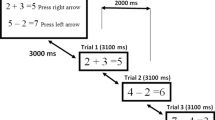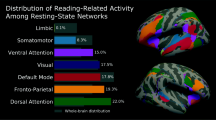Abstract
Developmental dyslexia, a neurodevelopment reading disorder, can impact even children with average intelligence. The present study examined the brain connectivity in dyslexic and control children during the reading task using graph theory. 19-channel electroencephalogram (EEG) signals were recorded from 15 dyslexic children and 15 control children. Functional connectivity was estimated by measuring the EEG coherence at 19 electrode locations, and graph measures were calculated using the graph theory method. Reading task results identified deprived task performance in dyslexic children against controls. Graph measures revealed longer path length, reduced clustering coefficient and reduced network efficiencies (in theta and alpha bands) of dyslexic group. At the nodal level, we found a significant increase in delta strength (T4 and T5 electrode locations) and reduced strength in theta (T6, P4, Fp1, F8 and F3) and alpha bands (T4, T3, P4 and F3) during the reading task in dyslexic group. In conclusion, the present study identified distinct graph measures between groups when performing a reading task and showed possible evidence for compromised brain networks in dyslexic group.
Graphical abstract















Similar content being viewed by others
Data availability
Data will be made available based on reasonable request.
Code availability
Code will be made available based on reasonable request.
References
Norton ES, Beach SD, Gabrieli JDE (2015) Neurobiology of dyslexia. Curr Opin Neurobiol 30:73–78
Peterson RL, Pennington BF (2012) Seminar: developmental dyslexia. Lancet 379:1997–2007. https://doi.org/10.1016/S0140-6736(12)60198-6.Seminar
Ozernov-Palchik O, Gaab N (2016) Tackling the ‘dyslexia paradox’: reading brain and behavior for early markers of developmental dyslexia. Wiley Interdiscip Rev Cogn Sci 7:156–176
Wagner RK, Zirps FA, Edwards AA et al (2020) The prevalence of dyslexia: a new approach to its estimation. J Learn Disabil 53:354–365
Bailey SK, Aboud KS, Nguyen TQ, Cutting LE (2018) Applying a network framework to the neurobiology of reading and dyslexia. J Neurodev Disord 10:1–9. https://doi.org/10.1186/s11689-018-9251-z
Ramus F (2004) Neurobiology of dyslexia : a reinterpretation of the data. Trends Neurosci 27:1–9
Fowler AE, Liberman AM, Shankweiler D et al (1995) Cognitive profiles of reading-disabled children: comparison of language skills in phonology, Morphology, and Syntax. Psychol Sci 6:149–156. https://doi.org/10.1111/j.1467-9280.1995.tb00324.x
Träff U, Passolunghi MC (2015) Mathematical skills in children with dyslexia. Learn Individ Differ 40:108–114. https://doi.org/10.1016/j.lindif.2015.03.024
Majerus S, Cowan N (2016) The nature of verbal short-term impairment in dyslexia: the importance of serial order. Front Psychol 7. https://doi.org/10.3389/fpsyg.2016.01522
Dushanova JA, Tsokov SA (2020) Small-world EEG network analysis of functional connectivity in developmental dyslexia after visual training intervention. J Integr Neurosci 19:601–618
Boets B, Op de Beeck HP, Vandermosten M et al (2013) Intact but less accessible phonetic representations in adults with dyslexia. Science (80-) 342:1251 LP–1254
van der Mark S, Klaver P, Bucher K et al (2011) The left occipitotemporal system in reading: disruption of focal fMRI connectivity to left inferior frontal and inferior parietal language areas in children with dyslexia. Neuroimage 54:2426–2436. https://doi.org/10.1016/j.neuroimage.2010.10.002
Vandermosten M, Boets B, Wouters J, Ghesquière P (2012) A qualitative and quantitative review of diffusion tensor imaging studies in reading and dyslexia. Neurosci Biobehav Rev 36:1532–1552. https://doi.org/10.1016/j.neubiorev.2012.04.002
Pugh KR, Mencl WE, Jenner AR et al (2000) Functional neuroimaging studies of reading and reading disability (developmental dyslexia). Ment Retard Dev Disabil Res Rev 6:207–213. https://doi.org/10.1002/1098-2779(2000)6:3%3c207::AID-MRDD8%3e3.0.CO;2-P
Shaywitz BA, Shaywitz SE, Pugh KR et al (2002) Disruption of posterior brain systems for reading in children with developmental dyslexia. Biol Psychiatry 52:101–110. https://doi.org/10.1016/S0006-3223(02)01365-3
Lou C, Duan X, Altarelli I et al (2019) White matter network connectivity deficits in developmental dyslexia. Hum Brain Mapp 40:505–516
Fraga González G, Van der Molen MJW, Žarić G et al (2016) Graph analysis of EEG resting state functional networks in dyslexic readers. Clin Neurophysiol 127:3165–3175
Seshadri NPG, Bikesh BG, Singh K (2021) EEG based functional brain networks analysis in dyslexic children during arithmetic task. Cogn Neurodyn 9. https://doi.org/10.1007/s11571-021-09769-9
Galin D, Raz J, Fein G et al (1992) EEG spectra in dyslexic and normal readers during oral and silent reading. Electroencephalogr Clin Neurophysiol 82:87–101
Arns M, Peters S, Breteler R, Verhoeven L (2007) Different brain activation patterns in dyslexic children: evidence from EEG power and coherence patterns for the double-deficit theory of dyslexia. J Integr Neurosci 6:175–190. https://doi.org/10.1142/S0219635207001404
Bullmore E, Sporns O (2009) Complex brain networks : graph theoretical analysis of structural and functional systems. Nat Rev Neurosci 10:186–198
Rubinov M, Sporns O (2010) NeuroImage complex network measures of brain connectivity : uses and interpretations. Neuroimage 52:1059–1069. https://doi.org/10.1016/j.neuroimage.2009.10.003
Zhu H, Qiu C, Meng Y et al (2017) Altered topological properties of brain networks in social anxiety disorder: a resting-state functional MRI study. Sci Rep 7:1–12
Sun S, Li X, Zhu J et al (2019) Graph theory analysis of functional connectivity in major depression disorder with high-density resting state EEG data. IEEE Trans Neural Syst Rehabil Eng 27:429–439
Mather N, Goldstein S, Eklund K (2001) Learning disabilities and challenging behaviors. Balt MD Brookes
Sinha UK (2007) Specific learning disability- screening questionnaire (SLD-SQ). New Delhi: Psychomatrix Corporation 2012
Kamat VV (1967) Measuring intelligence of Indian children. Oxford University Press, London, UK
Shah HR, Sagar JKV, Somaiya MP, Nagpal JK (2019) Clinical practice guidelines on assessment and management of specific learning disorders. Indian J Psychiatry 61:211
Raven J, Raven J, Court J (1998) Coloured progressive matrices. Oxford Psychologists Press, Oxford, UK
Achenbach TM (1991) Manual for the Child Behavior Checklist/4-18 and 1991 profile. VT Univ Vermont, Dep Psychiatry, Burlington
Balasubramanian G, Kanagasabai A, Jagannath M, Seshadri NPG (2018) Music induced emotion using wavelet packet decomposition—an EEG study. Biomed Signal Process Control 42:115–128
Maslov S, Sneppen K (2002) Specificity and stability in topology of protein networks. Science (80-) 296:910–913
Rubinov M, Sporns O (2010) Complex network measures of brain connectivity: uses and interpretations. Neuroimage 52:1059–1069
Hoeft F, Hernandez A, McMillon G et al (2006) Neural basis of dyslexia: a comparison between dyslexic and nondyslexic children equated for reading ability. J Neurosci 26:10700–10708
Shaywitz BA, Shaywitz SE, Pugh KR et al (2002) Disruption of posterior brain systems for reading in children with developmental dyslexia. Biol Psychiatry 52:101–110
Lachmann T, Berti S, Kujala T, Schröger E (2005) Diagnostic subgroups of developmental dyslexia have different deficits in neural processing of tones and phonemes. Int J Psychophysiol 56:105–120
Tong X, Chung KKH, McBride C (2014) Two-character Chinese compound word processing in Chinese children with and without dyslexia: ERP evidence. Dev Neuropsychol 39:285–301. https://doi.org/10.1080/87565641.2014.907720
La RD, Campisi P, Vegso B et al (2014) Human brain distinctiveness based on EEG spectral coherence connectivity. IEEE Trans Biomed Eng 61:2406–2412. https://doi.org/10.1109/TBME.2014.2317881
Parente F, Colosimo A (2020) Functional connections between and within brain subnetworks under resting-state. Sci Rep 10:1–13
He W, Sowman PF, Brock J et al (2019) Increased segregation of functional networks in developing brains. Neuroimage 200:607–620
Liu K, Shi L, Chen F et al (2015) Altered topological organization of brain structural network in Chinese children with developmental dyslexia. Neurosci Lett 589:169–175
Bosch-Bayard J, Girini K, Biscay RJ et al (2020) Resting EEG effective connectivity at the sources in developmental dysphonetic dyslexia. Differences with non-specific reading delay. Int J Psychophysiol 153:135–147
Dimitriadis SI, Simos PG, Fletcher JΜ, Papanicolaou AC (2018) Aberrant resting-state functional brain networks in dyslexia: symbolic mutual information analysis of neuromagnetic signals. Int J Psychophysiol 126:20–29
Yang J, Tan LH (2020) Whole-brain functional networks for phonological and orthographic processing in Chinese good and poor readers. Front Psychol 10:2945
Mao J, Liu L, Perkins K, Cao F (2021) Poor reading is characterized by a more connected network with wrong hubs. Brain Lang 220:104983
Hensel S, Rockstroh B, Berg P et al (2004) Left-hemispheric abnormal EEG activity in relation to impairment and recovery in aphasic patients. Psychophysiology 41:394–400. https://doi.org/10.1111/j.1469-8986.2004.00164x
Penolazzi B, Spironelli C, Angrilli A (2008) Delta EEG activity as a marker of dysfunctional linguistic processing in developmental dyslexia. Psychophysiology 45:1025–1033. https://doi.org/10.1111/j.1469-8986.2008.00709.x
Spironelli C, Penolazzi B, Angrilli A (2008) Dysfunctional hemispheric asymmetry of theta and beta EEG activity during linguistic tasks in developmental dyslexia. Biol Psychol 77:123–131. https://doi.org/10.1016/j.biopsycho.2007.09.009
von Stein A, Sarnthein J (2000) Different frequencies for different scales of cortical integration: from local gamma to long range alpha/theta synchronization. Int J Psychophysiol 38:301–313
Klimesch W, Schack B, Sauseng P (2005) The functional significance of theta and upper alpha oscillations. Exp Psychol 52:99–108. https://doi.org/10.1027/1618-3169.52.2.99
Güntekin B, Emek-Savaş DD, Kurt P et al (2013) Beta oscillatory responses in healthy subjects and subjects with mild cognitive impairment. NeuroImage Clin 3:39–46. https://doi.org/10.1016/j.nicl.2013.07.003
Perera H, Shiratuddin MF, Wong KW (2018) Review of EEG-based pattern classification frameworks for dyslexia. Brain Informatics 5
Acknowledgements
The authors would like to thank all the children and their parents for their participation. The authors are also grateful to the principals and psychologists of special schools who participated in this study.
Author information
Authors and Affiliations
Corresponding author
Ethics declarations
Ethics approval and consent to participate
This research protocol has been approved by the Institutional Ethical Committee, National Institute of Technology Raipur (NITRR/IEC/2019/02), and informed consent was obtained from all the participants/their parents.
Conflict of interest
The authors declare no competing interests.
Additional information
Publisher's Note
Springer Nature remains neutral with regard to jurisdictional claims in published maps and institutional affiliations.
Rights and permissions
Springer Nature or its licensor (e.g. a society or other partner) holds exclusive rights to this article under a publishing agreement with the author(s) or other rightsholder(s); author self-archiving of the accepted manuscript version of this article is solely governed by the terms of such publishing agreement and applicable law.
About this article
Cite this article
N. P., G., Singh, B.K. Analysis of reading-task-based brain connectivity in dyslexic children using EEG signals. Med Biol Eng Comput (2024). https://doi.org/10.1007/s11517-024-03085-0
Received:
Accepted:
Published:
DOI: https://doi.org/10.1007/s11517-024-03085-0




